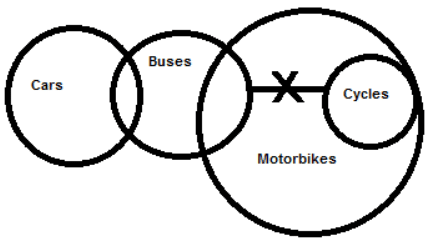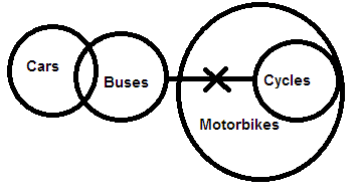SSC CGL Exam > SSC CGL Questions > Directions: In the following question, three...
Start Learning for Free
Directions: In the following question, three statements are given, which are followed by two conclusions numbered I and II. Consider the given statements to be true and then decide which of the given conclusions logically follow(s) from the given statements, disregarding commonly known facts.
Statements:
Some cars are buses.
No buses are cycles.
All cycles are motorbikes.
Conclusions:
I. Some cycles are not motorbikes.
II. No buses are motorbikes.
- a)Only conclusion I is true
- b)Only conclusion II is true
- c)Either conclusion I or II is true
- d)Neither conclusion I nor II is true
Correct answer is option 'D'. Can you explain this answer?
Most Upvoted Answer
Directions: In the following question, three statements are given, wh...
There are two possibilities.


Or

Free Test
FREE
| Start Free Test |
Community Answer
Directions: In the following question, three statements are given, wh...
Given Statements:
• Some cars are buses.
• No buses are cycles.
• All cycles are motorbikes.
Conclusion I: Some cycles are not motorbikes.
Conclusion II: No buses are motorbikes.
Explanation:
To determine the truth of the given conclusions, we need to analyze the given statements.
• Some cars are buses and all cycles are motorbikes: This means that some cycles can also be buses.
• No buses are cycles: This means that no cycle can be a bus or any bus can be a cycle.
Conclusion I: Some cycles are not motorbikes.
From the given statements, we cannot conclude that some cycles are not motorbikes because it is already stated that all cycles are motorbikes. Hence, conclusion I is false.
Conclusion II: No buses are motorbikes.
From the given statements, we know that no bus is a cycle and some cars are buses. But we cannot conclude that no bus is a motorbike because there is no direct relationship given between buses and motorbikes. Therefore, conclusion II is also false.
Hence, neither conclusion I nor II follows from the given statements. The correct answer is option D.
• Some cars are buses.
• No buses are cycles.
• All cycles are motorbikes.
Conclusion I: Some cycles are not motorbikes.
Conclusion II: No buses are motorbikes.
Explanation:
To determine the truth of the given conclusions, we need to analyze the given statements.
• Some cars are buses and all cycles are motorbikes: This means that some cycles can also be buses.
• No buses are cycles: This means that no cycle can be a bus or any bus can be a cycle.
Conclusion I: Some cycles are not motorbikes.
From the given statements, we cannot conclude that some cycles are not motorbikes because it is already stated that all cycles are motorbikes. Hence, conclusion I is false.
Conclusion II: No buses are motorbikes.
From the given statements, we know that no bus is a cycle and some cars are buses. But we cannot conclude that no bus is a motorbike because there is no direct relationship given between buses and motorbikes. Therefore, conclusion II is also false.
Hence, neither conclusion I nor II follows from the given statements. The correct answer is option D.

|
Explore Courses for SSC CGL exam
|

|
Similar SSC CGL Doubts
Question Description
Directions: In the following question, three statements are given, which are followed by two conclusions numbered I and II. Consider the given statements to be true and then decide which of the given conclusions logically follow(s) from the given statements, disregarding commonly known facts.Statements:Some cars are buses.No buses are cycles.All cycles are motorbikes.Conclusions:I. Some cycles are not motorbikes.II. No buses are motorbikes.a)Only conclusion I is trueb)Only conclusion II is truec)Either conclusion I or II is trued)Neither conclusion I nor II is trueCorrect answer is option 'D'. Can you explain this answer? for SSC CGL 2025 is part of SSC CGL preparation. The Question and answers have been prepared according to the SSC CGL exam syllabus. Information about Directions: In the following question, three statements are given, which are followed by two conclusions numbered I and II. Consider the given statements to be true and then decide which of the given conclusions logically follow(s) from the given statements, disregarding commonly known facts.Statements:Some cars are buses.No buses are cycles.All cycles are motorbikes.Conclusions:I. Some cycles are not motorbikes.II. No buses are motorbikes.a)Only conclusion I is trueb)Only conclusion II is truec)Either conclusion I or II is trued)Neither conclusion I nor II is trueCorrect answer is option 'D'. Can you explain this answer? covers all topics & solutions for SSC CGL 2025 Exam. Find important definitions, questions, meanings, examples, exercises and tests below for Directions: In the following question, three statements are given, which are followed by two conclusions numbered I and II. Consider the given statements to be true and then decide which of the given conclusions logically follow(s) from the given statements, disregarding commonly known facts.Statements:Some cars are buses.No buses are cycles.All cycles are motorbikes.Conclusions:I. Some cycles are not motorbikes.II. No buses are motorbikes.a)Only conclusion I is trueb)Only conclusion II is truec)Either conclusion I or II is trued)Neither conclusion I nor II is trueCorrect answer is option 'D'. Can you explain this answer?.
Directions: In the following question, three statements are given, which are followed by two conclusions numbered I and II. Consider the given statements to be true and then decide which of the given conclusions logically follow(s) from the given statements, disregarding commonly known facts.Statements:Some cars are buses.No buses are cycles.All cycles are motorbikes.Conclusions:I. Some cycles are not motorbikes.II. No buses are motorbikes.a)Only conclusion I is trueb)Only conclusion II is truec)Either conclusion I or II is trued)Neither conclusion I nor II is trueCorrect answer is option 'D'. Can you explain this answer? for SSC CGL 2025 is part of SSC CGL preparation. The Question and answers have been prepared according to the SSC CGL exam syllabus. Information about Directions: In the following question, three statements are given, which are followed by two conclusions numbered I and II. Consider the given statements to be true and then decide which of the given conclusions logically follow(s) from the given statements, disregarding commonly known facts.Statements:Some cars are buses.No buses are cycles.All cycles are motorbikes.Conclusions:I. Some cycles are not motorbikes.II. No buses are motorbikes.a)Only conclusion I is trueb)Only conclusion II is truec)Either conclusion I or II is trued)Neither conclusion I nor II is trueCorrect answer is option 'D'. Can you explain this answer? covers all topics & solutions for SSC CGL 2025 Exam. Find important definitions, questions, meanings, examples, exercises and tests below for Directions: In the following question, three statements are given, which are followed by two conclusions numbered I and II. Consider the given statements to be true and then decide which of the given conclusions logically follow(s) from the given statements, disregarding commonly known facts.Statements:Some cars are buses.No buses are cycles.All cycles are motorbikes.Conclusions:I. Some cycles are not motorbikes.II. No buses are motorbikes.a)Only conclusion I is trueb)Only conclusion II is truec)Either conclusion I or II is trued)Neither conclusion I nor II is trueCorrect answer is option 'D'. Can you explain this answer?.
Solutions for Directions: In the following question, three statements are given, which are followed by two conclusions numbered I and II. Consider the given statements to be true and then decide which of the given conclusions logically follow(s) from the given statements, disregarding commonly known facts.Statements:Some cars are buses.No buses are cycles.All cycles are motorbikes.Conclusions:I. Some cycles are not motorbikes.II. No buses are motorbikes.a)Only conclusion I is trueb)Only conclusion II is truec)Either conclusion I or II is trued)Neither conclusion I nor II is trueCorrect answer is option 'D'. Can you explain this answer? in English & in Hindi are available as part of our courses for SSC CGL.
Download more important topics, notes, lectures and mock test series for SSC CGL Exam by signing up for free.
Here you can find the meaning of Directions: In the following question, three statements are given, which are followed by two conclusions numbered I and II. Consider the given statements to be true and then decide which of the given conclusions logically follow(s) from the given statements, disregarding commonly known facts.Statements:Some cars are buses.No buses are cycles.All cycles are motorbikes.Conclusions:I. Some cycles are not motorbikes.II. No buses are motorbikes.a)Only conclusion I is trueb)Only conclusion II is truec)Either conclusion I or II is trued)Neither conclusion I nor II is trueCorrect answer is option 'D'. Can you explain this answer? defined & explained in the simplest way possible. Besides giving the explanation of
Directions: In the following question, three statements are given, which are followed by two conclusions numbered I and II. Consider the given statements to be true and then decide which of the given conclusions logically follow(s) from the given statements, disregarding commonly known facts.Statements:Some cars are buses.No buses are cycles.All cycles are motorbikes.Conclusions:I. Some cycles are not motorbikes.II. No buses are motorbikes.a)Only conclusion I is trueb)Only conclusion II is truec)Either conclusion I or II is trued)Neither conclusion I nor II is trueCorrect answer is option 'D'. Can you explain this answer?, a detailed solution for Directions: In the following question, three statements are given, which are followed by two conclusions numbered I and II. Consider the given statements to be true and then decide which of the given conclusions logically follow(s) from the given statements, disregarding commonly known facts.Statements:Some cars are buses.No buses are cycles.All cycles are motorbikes.Conclusions:I. Some cycles are not motorbikes.II. No buses are motorbikes.a)Only conclusion I is trueb)Only conclusion II is truec)Either conclusion I or II is trued)Neither conclusion I nor II is trueCorrect answer is option 'D'. Can you explain this answer? has been provided alongside types of Directions: In the following question, three statements are given, which are followed by two conclusions numbered I and II. Consider the given statements to be true and then decide which of the given conclusions logically follow(s) from the given statements, disregarding commonly known facts.Statements:Some cars are buses.No buses are cycles.All cycles are motorbikes.Conclusions:I. Some cycles are not motorbikes.II. No buses are motorbikes.a)Only conclusion I is trueb)Only conclusion II is truec)Either conclusion I or II is trued)Neither conclusion I nor II is trueCorrect answer is option 'D'. Can you explain this answer? theory, EduRev gives you an
ample number of questions to practice Directions: In the following question, three statements are given, which are followed by two conclusions numbered I and II. Consider the given statements to be true and then decide which of the given conclusions logically follow(s) from the given statements, disregarding commonly known facts.Statements:Some cars are buses.No buses are cycles.All cycles are motorbikes.Conclusions:I. Some cycles are not motorbikes.II. No buses are motorbikes.a)Only conclusion I is trueb)Only conclusion II is truec)Either conclusion I or II is trued)Neither conclusion I nor II is trueCorrect answer is option 'D'. Can you explain this answer? tests, examples and also practice SSC CGL tests.

|
Explore Courses for SSC CGL exam
|

|
Signup to solve all Doubts
Signup to see your scores go up within 7 days! Learn & Practice with 1000+ FREE Notes, Videos & Tests.


























